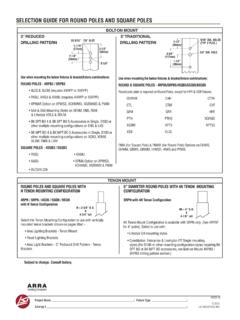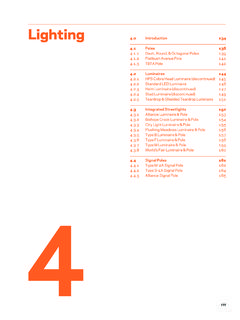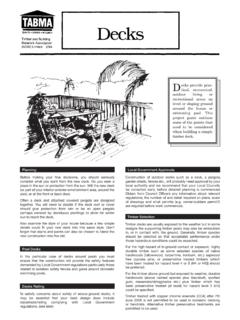Transcription of 4 Lighting - Welcome to NYC.gov | City of New York
1 Introduction ..151 Street Lighting .. Cobra Head .. Stad .. Fulton .. Alliance ..160 Helm ..161 Flatbush Avenue .. TBTA .. Type M .. Type F .. Bishops Crook .. Blank Page .. City Light .. Blank Page .. LED Type E .. Pedestrian Lighting .. Cobra Head .. Stad .. Fulton .. Flushing Meadows .. Type B .. World s Fair .. TBTA .. round Top Head .. LED Post Top .. Blank Page .. Blank Page ..184 Traffic Signal Poles .. Type M 2 Traffic Signal pole ..186 Alliance Traffic Signal pole ..188 150 LIgHTINgLuminairesStandard PolesOptional PolesHistoric PolesDavitOctagonalroundTBTAF ultonFlushing MeadowsType BWorld s FairCobra Head Stad Fulton Flushing Meadows Helm Teardrop Shielded Teardrop Type B World s Fair This combination of an optional pole with the Teardrop or Shielded Teardrop luminaire creates a historic lightLighting reference DOT ApprovedStreet Lighting DOT Approved Pedestrian Lighting CombinationsLuminairesStandard PolesOptional PolesHistoric PolesDavitOctagonalroundFlatbush AllianceTBTAWMF ultonType MType FBishops CrookCobra Head Stad Fulton Alliance Helm
2 Teardrop Shielded Teardrop This combination of an optional pole with the Teardrop or Shielded Teardrop luminaire creates a historic light151 LIgHTINgAbout this ChapterThis chapter outlines options for both new and replacement street Lighting for use on New York City streets. Included are those fixtures that meet NYC DOT engineering standards, as well as technical requirements for safety and energy efficiency and for use in a variety of contexts. Selection CriteriaFixture types (luminaires) are categorized as Standard, Optional, Historic, and Pilot fixture types for both Street Lights and Pedestrian Lights (see detailed descriptions of these usage categories below).
3 Only the fixtures that are described in the Standard category will be provided and maintained by NYC DOT. All other fixtures must be separately funded; and under certain conditions, will be maintained by NYC DOT. Where energy consumption and quantity of fixtures exceeds NYC DOT Standard, a separate maintenance agreement will be Luminaires & Poles The selection of Lighting includes the specification of both a pole and luminaire. The desired aesthetic and engineering outcomes can be achieved by combining luminaires with different poles. Acceptable combinations are described in this chapter. o energy guidelines To comply with current citywide energy guidelines, most of the fixtures are available with 150W (watt) and 100W high pressure sodium (HPS) lamps.
4 Energy costs that exceed the 150W standard and 100W standard must be separately funded. NYC DOT engineers will determine where the use of 150W or 100W is appropriate for the particular engineering review In all cases, the suitability of the fixture type for particular street and Lighting conditions must be approved by NYC DOT CategoriesStandardThese luminaire and pole types will be provided and maintained by NYC DOT. The current standard luminaires for New York City streets are the 100W and 150W Cobra Head (for street Lighting ) and the 70W and 100W Cobra Head (for pedestrian Lighting ). For street Lighting and pedestrian Lighting , the standard pole types are the Davit, round , and Octagonal poles.
5 The M 2 Traffic Signal pole is standard for use at all traffic signal luminaires and poles require additional funding for the initial cost of the fixtures. In an effort to reduce carbon emissions citywide, the additional energy costs above the 150W (for street Lighting ) or 70W and 100W (for pedestrian Lighting ) standards will also require additional funding for all projects authorized after December 31, 2008. HistoricHistoric fixtures are intended for use in Landmark districts that are designated by the New York City Landmark Preservation Commission (LPC) or for neighborhoods that have substantial historic fabric intact.
6 They will require special approval by NYC DOT and the Design Commission (DC) for use in other areas. Most historic poles are currently used with only one luminaire, the 250W or 150W teardrop. Until alternate historic luminaires of lower wattage are available that meet NYC DOT technical requirements, this is the only option These luminaires are not yet approved for use in New York City. Many of them are currently or soon to be tested. They will require NYC DOT approval prior to specification for any IntroductionSpacing/Typicalx:Y: The spacing of streetlights is dependant on several factors, including the height of the pole , street width, the amount of light the fixture provides, and the Lighting levels necessary for the particular street classification.
7 The information provided in this chapter is intended as a guideline to indicate that additional poles and/or fixtures may be required in the selection of certain luminaires. The spacing between poles is described as a ratio in comparison to the Standard luminaire and pole (SLP), which is currently the Cobra Head luminaire on a round , octagonal, or davit pole . A ratio of 1:1 indicates that an equal number of poles and luminaires would be required for replacement. A ratio of :1indicates twice as many luminaires and poles would be required to achieve similar Lighting levels as the LevelsLighting levels are based on the guidelines established by the IESNA.
8 All Lighting designs must be reviewed and approved by NYC DOT design criteria, technical information, finishes, and color specification, refer to Bureau of Traffic Division of Streetlighting Specifications. The latest edition is available from the NYC Department of Outdoor luminaires may be categorized according to the four classifications established by the IESNA of full cutoff, cutoff, semi cutoff, and non cutoff to distinguish the range in quantity of upward light and light above a horizontal plane emitted by a light Full cutoff: Full cutoff fixtures do not emit any upward light (at or above 90 degrees) and up to 10% of their light at or above 80 degrees.
9 They create the narrowest spread of light. o Cutoff: Cutoff fixtures emit up to of their light upward (at or above 90 degrees) and up to 10% of their light at or above 80 degrees. They create a slightly wider spread of light. o Semi Cutoff: Semi cutoff fixtures emit up to 5% of their light upward (at or above 90 degrees), and up to 20% of their light at or above 80 degrees. They create a wider spread of light. o Non Cutoff: Non cutoff fixtures emit light in all directions. They create the widest spread of light. 153 LIgHTINgNotes and SymbolsHPS High Pressure SodiumLeD Light Emitting DiodeHDg Hot Dipped Galvanized SteelSLP Standard Luminaire and pole (cobra head on round , octagonal, or davit pole )IeSNA Illuminating Engineering Society of North AmericaIeS Type Pattern of light distribution defined by the Illuminating Engineering Watts$ Costs: Shown for each luminaire as a $ symbol, representing relative costs compared to the Standard Luminaire and pole (SLP).
10 Because actual costs are subject to change, a scale of one to five $ symbols is used rather than specific monetary Introduction154154p e d e s t r i a n l i g h t i n g: o p t i o n a l l u m i n a i r e s a n d p o l e s Street LightingStreet LightingLIgHTINg155 Lighting : STreeT Cobra HeadCobra HeadUSAge: STANDArDThe Cobra Head luminaire was originally introduced by the Westinghouse and General Electric companies in 1957 to accompany an aluminum post designed in 1958 by Donald Deskey and first installed in 1963. Additional poles were later introduced to support the Cobra Head luminaire: the Octagonal, round , and Davit.
















